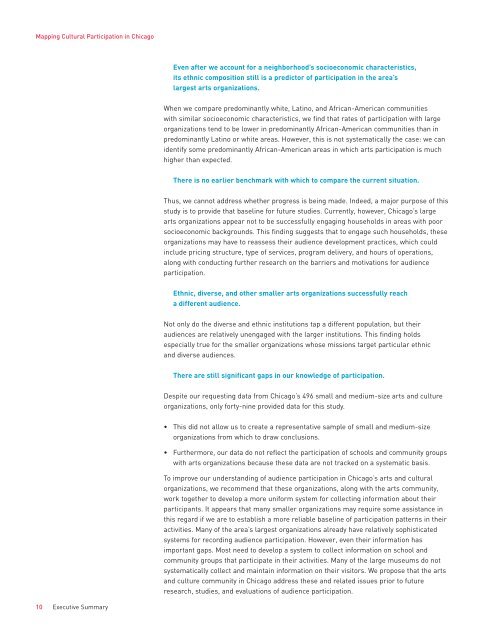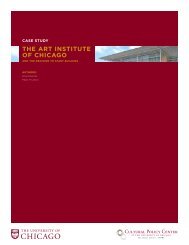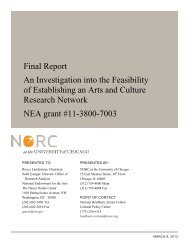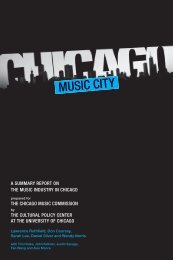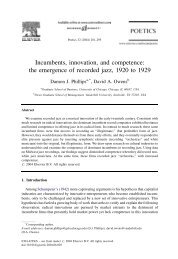Mapping Cultural Participation in Chicago - Cultural Policy Center
Mapping Cultural Participation in Chicago - Cultural Policy Center
Mapping Cultural Participation in Chicago - Cultural Policy Center
Create successful ePaper yourself
Turn your PDF publications into a flip-book with our unique Google optimized e-Paper software.
<strong>Mapp<strong>in</strong>g</strong> <strong>Cultural</strong> <strong>Participation</strong> <strong>in</strong> <strong>Chicago</strong>Even after we account for a neighborhood’s socioeconomic characteristics,its ethnic composition still is a predictor of participation <strong>in</strong> the area’slargest arts organizations.When we compare predom<strong>in</strong>antly white, Lat<strong>in</strong>o, and African-American communitieswith similar socioeconomic characteristics, we f<strong>in</strong>d that rates of participation with largeorganizations tend to be lower <strong>in</strong> predom<strong>in</strong>antly African-American communities than <strong>in</strong>predom<strong>in</strong>antly Lat<strong>in</strong>o or white areas. However, this is not systematically the case: we canidentify some predom<strong>in</strong>antly African-American areas <strong>in</strong> which arts participation is muchhigher than expected.There is no earlier benchmark with which to compare the current situation.Thus, we cannot address whether progress is be<strong>in</strong>g made. Indeed, a major purpose of thisstudy is to provide that basel<strong>in</strong>e for future studies. Currently, however, <strong>Chicago</strong>’s largearts organizations appear not to be successfully engag<strong>in</strong>g households <strong>in</strong> areas with poorsocioeconomic backgrounds. This f<strong>in</strong>d<strong>in</strong>g suggests that to engage such households, theseorganizations may have to reassess their audience development practices, which could<strong>in</strong>clude pric<strong>in</strong>g structure, type of services, program delivery, and hours of operations,along with conduct<strong>in</strong>g further research on the barriers and motivations for audienceparticipation.Ethnic, diverse, and other smaller arts organizations successfully reacha different audience.Not only do the diverse and ethnic <strong>in</strong>stitutions tap a different population, but theiraudiences are relatively unengaged with the larger <strong>in</strong>stitutions. This f<strong>in</strong>d<strong>in</strong>g holdsespecially true for the smaller organizations whose missions target particular ethnicand diverse audiences.There are still significant gaps <strong>in</strong> our knowledge of participation.Despite our request<strong>in</strong>g data from <strong>Chicago</strong>’s 496 small and medium-size arts and cultureorganizations, only forty-n<strong>in</strong>e provided data for this study.• This did not allow us to create a representative sample of small and medium-sizeorganizations from which to draw conclusions.• Furthermore, our data do not reflect the participation of schools and community groupswith arts organizations because these data are not tracked on a systematic basis.To improve our understand<strong>in</strong>g of audience participation <strong>in</strong> <strong>Chicago</strong>’s arts and culturalorganizations, we recommend that these organizations, along with the arts community,work together to develop a more uniform system for collect<strong>in</strong>g <strong>in</strong>formation about theirparticipants. It appears that many smaller organizations may require some assistance <strong>in</strong>this regard if we are to establish a more reliable basel<strong>in</strong>e of participation patterns <strong>in</strong> theiractivities. Many of the area’s largest organizations already have relatively sophisticatedsystems for record<strong>in</strong>g audience participation. However, even their <strong>in</strong>formation hasimportant gaps. Most need to develop a system to collect <strong>in</strong>formation on school andcommunity groups that participate <strong>in</strong> their activities. Many of the large museums do notsystematically collect and ma<strong>in</strong>ta<strong>in</strong> <strong>in</strong>formation on their visitors. We propose that the artsand culture community <strong>in</strong> <strong>Chicago</strong> address these and related issues prior to futureresearch, studies, and evaluations of audience participation.10 Executive Summary


